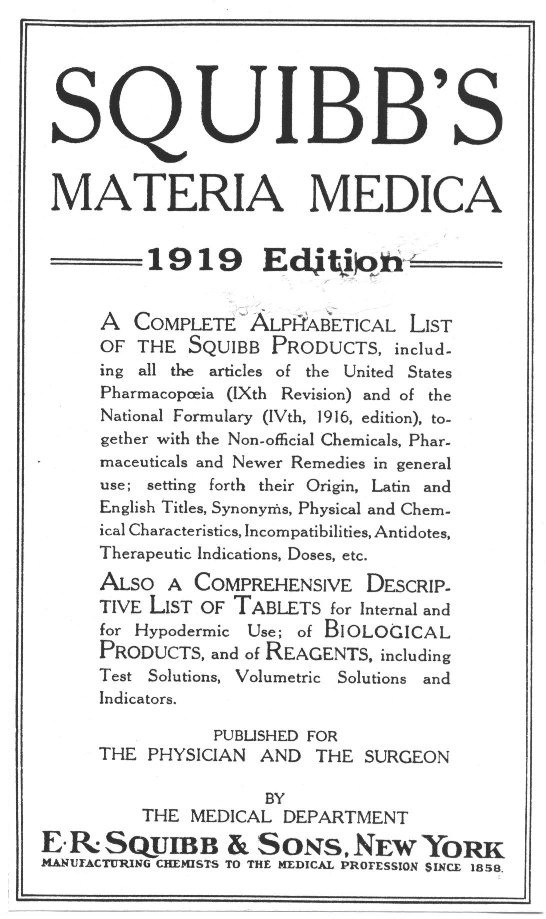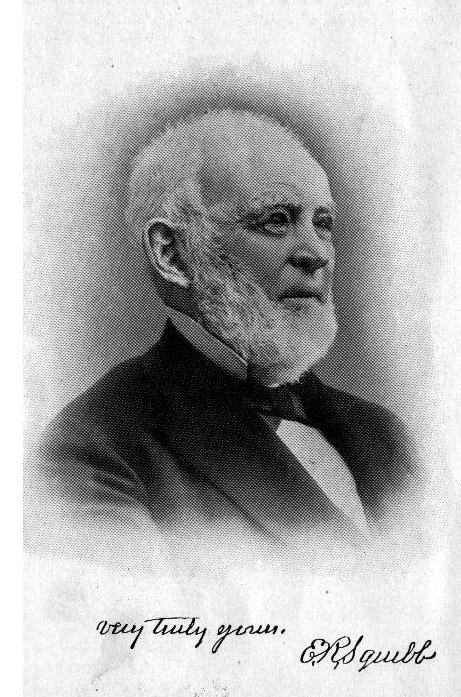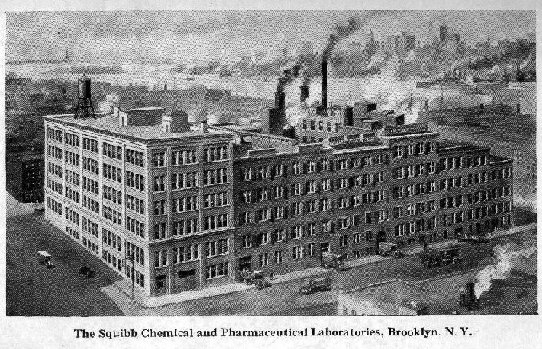A Pharmaceutical Product Catalog
E. R. Squibb & Sons (1919)
Chapter 13
E. R. Squibb & Sons (1919)
Chapter 13

13.1 - Squibb's Materia Medica (1919 edition) Product Catalog:
Old pharmaceutical product catalogs can provide a wealth of information. Obviously, their main use for the antique collector today, is to help identify and find pre-1940 medical Cannabis products. But they also seem to have the power to allow us to travel back in time, literally, they can take us right into the very minds and lives of the pharmacists who were making these drugs themselves.
To demonstrate this point, we've chosen (at random) to reproduce selected parts of the E. R. Squibb's & Sons Co., (1919 edition) pharmaceutical houses product and price catalog.
Please keep in mind, that NO attempt will be made to list all Cannabis product references; No veterinary (see chapter 14) products are shown etc.

E. R. SQUIBB
13.2 - Squibb's Materia Medica (1919 edition) Product Catalog:
In an age of generic medicines (when all pharmaceutical houses were making, essentially, the same products) Quality and name recognition were the main selling points.
Thus the first few pages of any sales catalog were usually reserved for pictures of the company founder or president and/or their manufacturing facilities, and so forth. The idea seems to be to project an image of strength, stability and trust.


13.3 - A Pharmaceutical Product Catalog:
By the late 19th century two distinct groups of drug manufacturers had emerged; the patent medicine manufacturers, which included Quacks (a subject saved for chapter 15); and the more legitimate standard or generic pharmaceutical houses.
These Generic drug manufacturers (which included such companies as Eli Lilly, Abbott Labs, Parke Davis, etc.) manufactured mostly tried-and-true drugs which were accepted by the established medical community. These, for the most part, were generic medicines to which every pharmacist knew the formulation. According to the journal of the American Pharmaceutical Association:
"The American Pharmaceutical industry of the early 20th century was predominantly a manufacturing industry. Individual companies started by serving a geographical region with an assorted line of standard products or by championing a specific dosage form or manufacturing process. The catalogues of the larger manufacturers ran to several hundred pages, . . . When one company brought a new product to market, it could be quickly copied and supplied by a number of other companies. Innovation was not characteristic of the industry." - J.A.P.A. - Sept/Oct. 2001 pg. 657Once again, while looking over these products, the reader should keep in mind that most drugs during this era (with the exception of the patent medicines) were generic in nature and therefore the ingredients and formulation were readily given. Also note the sheer number of Cannabis products per manufacturer. By this author's own estimates almost 6% of all manufactured drugs at the turn of the century contained Cannabis in one form or another.
Selected Catalog Pages:
Page - 39 - Cannabis (bulk)
Page - 82 - Extract Cannabis Powder
Page - 82 - Extract Cannabis Soft bulk
Page - 96 - Fluid Extract Cannabis
Page - 273 - Tincture Cannabis
Page - 300 - Tablets Acetanilid and Cannabis compound
Page - 343 - Tablets Cannabis Extract
Page - 343 - Tablets Cannabis and Aconite compound [Brown-Sequard]
Page - 343 - Tablets cannabis and Aconite Compound 1/2 strength
Page - 344 - Tablets Cannabis and Hyoscyamus compound
Page - 344 - Tablets Cannabis and Strychnine compound
Page - 381 - Tablets Nerve Tonic No.5
Page - 381 - Tablets Neuralgic (Dr. Kenyon)
Page - 381 - Tablets Neuralgic Brown-Sequard
Page - 381 - Tablets Neuralgic Brown-Squard (Half Strength)
Page - 381 - Tablets Neuralgic Improved
Page - 421 - Tablets Triple Bromides and Cannabis Compound
Page - 424 - Tablets Zinc Phosphide and Cannabis Compound
Page - 424 - Tablets Zinc Phosphide, Cannabis and Nux
13.4 - Pharmaceutical Catalogs as Reference:
Although old pharmaceutical sales/price/product catalogs are still seen by many antique collectors as being limited to the domain of antiquarian or used bookstores. Because these catalogs are chuck full of information about Cannabis medicines, (and about 6% of all pre-1937 medicines contained Cannabis), they have now become an excellent source of reference for collectors trying to determine which medicines did or did not contain Cannabis. Thus, they are now beginning to find their way into more and more antique malls.
In addition, because these catalogs were originally published for the exclusive use of physicians and pharmacists (and not for the general public), they contain a wealth of information; such as ingredients, formula percentages and diagnoses charts.
The table below gives a random list of some pharmaceutical catalogs listing how many Cannabis products each company was manufacturing at the time.
|
Pharmaceutical House |
Year Pub. |
Number of Cannabis Entries |
|
Abbott Laboratories |
1935 |
4 |
|
E.R. Squibb & Sons |
1919 |
15 |
|
Parke Davies |
1893 |
27 |
|
UpJohn & Co. |
1911 |
30 |
|
Eli Lilly |
1930 |
23 |
|
John Wyeth & Brother Co. |
1925 |
11 |
|
Merck. |
1899 |
1 |
|
Maltbie |
1937 |
10 |
|
Chicago Pharmacal Co. |
1920 |
21 |
|
Smith Kline |
1906 |
16 |
|
H. K. Milford Co. |
1921 |
20 |
|
Johnson & Johnson |
1905 |
1 |
|
National Drug Co. |
1931 |
20 |
See Appendix A, for a more complete list of pre-1937 medical Cannabis manufacturers.
13.5 - Selected Sections From the Catalog:

"The prices of the Squibb Products are in all instances as the quality and quantity of ingredients and the expense of manufacture allow. They include containers, packing and boxing. When ordering or prescribing medicinal products, specify SQUIBB's."While some may say this is all "just a good marketing ploy," just another way of saying "high prices" and "limited product line." I for one do not believe so. Given an age when "Quack Medicines," were still in circulation, I truly believe that their comments were sincere---Such nuances (in one form or another) can be found on many of the catalogs.
"This house supplies only one quality of each product; that best suited to the purposes intended. . . . Therefore, when prescribing, specify SQUIBB's."
"Recognized everywhere as the Quality Standard. They are of uniform purity and strength."
Also of interest is how they list their veterinary products right on in with everything else. This can only be explained by the importance of animals (especially for transportation) before the development of the gasoline engine.
Last of all, it is interesting to note that as these catalogs were originally meant for doctors, pharmacists etc., and so many of the back pages were devoted to such subjects as "Diseases and what manufacturer's drugs were recommended for there treatment".
In addition, many pages would be used to advertise or discuss the manufacturers quality standards. The two selected pages (shown below) give a good example.
Selected Catalog Pages:
Page - 528 - Tincture Cannabis
Page - 529 - General info
13.6 - PRICES:
Prices of old pharmaceutical catalogs vary widely from one used-bookstore to another. From $10 for poor copies of common Parke-Davis catalogs, to more than $500 for a rare copy of a Tilden & Co. 1858 catalog. For the latest up-to-date pricing information, I recommend that the reader view such web sites as:
- www.abebooks.com
- www.bookfinder.com
- www.biblion.com
- www.bibliology.com/http/search/search.html
- www.antbo.com
- www.tomfolio.com
- www.usedbookcentral.com
- www.amazon.com/exec/obidos/ats-query-page/102-5954689-6678541
- www.bookavenue.com
- www.bibliodirect.com
- www.alibris.com/search/search.cfm
- half.ebay.com/index.cfm?ad=1781
- www.antiqbook.com
- www.ilab-lila.com
- www.bibliopoly.com
- www.ecampus.com/default.asp?Referrer=617
- www.powells.com/search/DTSearch/search.cgi
WANT BETTER PICTURES: All pictures are available in CD-Rom Format from the Museum. CD-Rom is free of charge, but we do ask for a dollar donation to offset postage as well as actual cost of the media.
 Back to Previous Chapter |
BACK TO MAIN INDEX PAGE |
 On to the Next Chapter |